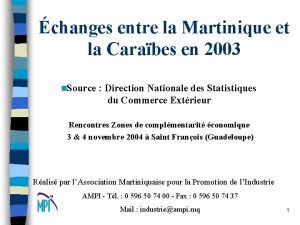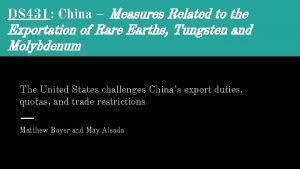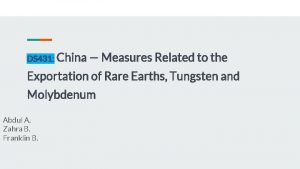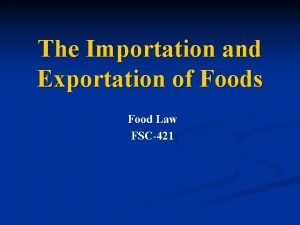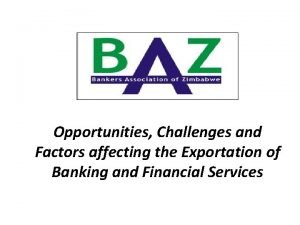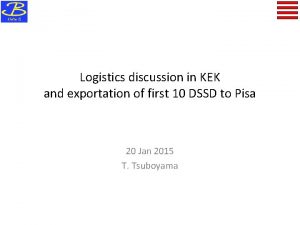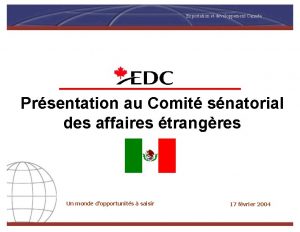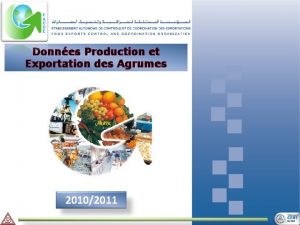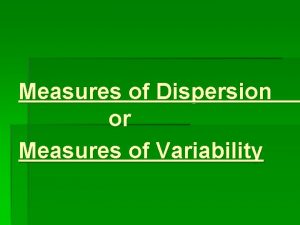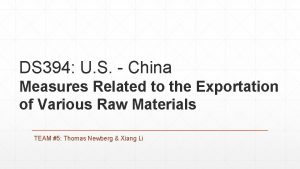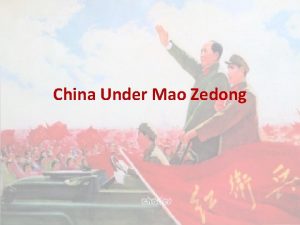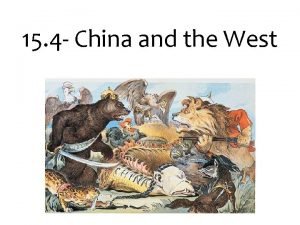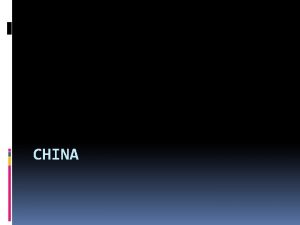1 China Measures Related to the Exportation of






















- Slides: 22

1 China — Measures Related to the Exportation of Various Raw Materials DSU 394 Team 5 Marina Gayed Miray Gooding Orbora Gumatho

2 Overview

3 History Since China’s accession into the WTO, several cases have been filed against China by member countries June 23, 2009, the United States filed a case against China for imposing export restrictions on raw materials Other third parties also requested to join consultations (EU, Mexico, Canada, Turkey)

4 Brief Overview Complainant: United States Respondent: China Third Parties: Argentina, Brazil, Canada, Chile, Colombia, Ecuador, European Union, India, Japan, Republic of Korea, Mexico, Norway, Chinese Taipei, Turkey, Kingdom of Saudi Arabia Export restrictions imposed on different raw materials Products at issue: Bauxite, coke, fluorspar, magnesium, manganese, silicon carbide, silicon metal, yellow phosphorus and zinc (China is a leading producer of each of the raw materials)

5 Timeline of Proceedings June 23, 2009 – Request for Consultations November 4, 2009 – US Requests Establishment of Panel December 21, 2009 – Establishment of a Panel July 5, 2011 – Panel Report Circulated – Panel upheld most claims against China; China appeals January 30, 2012 – AB report Circulated (AB upheld majority of the Panel’s recommendations; China to implement recommendations) February 22, 2012 – Adoption January 28, 2013 – Implementation

6 Violations

7 Agreements/Specific Provisions The United States considers that China, through these measures as well as any amendments, replacements, related measures, and implementing measures, is in violation of: Article VIII: Fees & Regulations associated with Imports & Exports. Article X: Publication & Administration of Trade Regulations. Article XI: General Elimination of Quantitative Restrictions Paragraphs 5. 1, 5. 2, 8. 2, and 11. 3 of Part I of China’s Protocol of Accession as well as China's obligations under the provisions of paragraph 1. 2 of Part I of the Accession Protocol

8 Agreements/Specific Provisions Paragraph 1. 2: General Provisions Paragraph 5. 1 and 5. 2: Right to Trade Paragraph 8. 2: Import and Export Licensing Paragraph 11. 3: Taxes and Charges Levied on Imports and Exports

9 Agreements/Specific Provisions Article VIII: Fees & Regulations associated with Imports & Exports VIII: 1: Fees & charges of any character in imports & exports to be abolished. Reduction of number and diversity of charges under Article VIII: 1(a). Minimization of trade complexities.

10 Agreements/Specific Provisions Article VIII: 4: To be applied on consular transactions. Quantifiable constraints. Licenses. Control of exchange. Statistical service. Documentation. Inspections & analysis. Sanitation & fumigation.

11 Agreements/Specific Provisions Article X: Publication & Administration of Trade Regulations Article X: 1: Regarding publication of all judicial decisions, regulations & administrative directions. Article X: 3: Administration of laws & regulations to be impartial & just. Regarding customs issues, the contracting parties will establish administrative, arbitral or judicial tribunals. Territorial laws will not be affected in relation to Application of Article X: 3(b)

12 Agreements/Specific Provisions Article XI: General Elimination of Quantitative Restrictions Article XI: 1: Restrictions & duties other than those covered in Article VIII: 1(a) will be abolished or not instituted.

13 Results

14 Panel Report 4 types of export restraints: (i) export duties (ii) export quotas (iii) minimum export price requirements (iv) export licensing Complainants: argued that the use of export restraints creates scarcity and causes higher prices of the raw materials in global markets; also Chinese domestic industry has advantage by way of a sufficient supply, and lower and more stable prices for the raw materials

15 Panel Report Upon accession of the WTO, China committed to more liberalization by agreeing to eliminate export duties (except for some products listed in the Protocol) China also committed not to apply export quotas (restrictions on the amount that can be exported); export duties and quotas were applied – violation of Protocol of Accession

16 Panel Report Key finding: China’s export duties and export quotas inconsistent with WTO rules Wording of China’s Protocol of Accession did not allow to use general exceptions in Article XX of GATT 1944 to justify its WTO inconsistent export duties; China did not comply with requirements of exceptions. China argued: export duties and quotas were justified because they related to the conservation of exhaustible natural resources for some of the raw materials Panel: China heading in the right direction by adopting framework to justify quotas under WTO rules; framework not yet consistent with WTO China: export quotas and duties necessary for health of citizens – failed to demonstrate that restrictions would limit pollution Panel: China's export licensing regime, applicable to several of the products at issue, restrict the export of the raw materials and so are inconsistent with WTO rules

17 Appellate Body Report The Appellate Body found that the section of the respondents’ panel requests that related to “additional restrictions imposed on exportation” did not comply with the requirements of Art. 6. 2 to “identify the specific measures at issue and provide a brief summary of the legal basis of the complaint sufficient to present the problem clearly “Right to trade” - China in support of entrepreneurial - market access and nondiscrimination as outlined by WTO The Appellate Body upheld the Panel’s recommendation that China bring its export duty and export quota measures into conformity with its WTO The Appellate Body upheld the Panel’s finding that there is no basis in China’s Accession Protocol to allow the application of Art. XX to China’s obligations under para. 11. 3 of the Protocol. The Panel had concluded that China’s export restraints were not justified pursuant to Arts. XX(b) and (g). These findings were not appealed.

18 Appellate Body Report The Appellate Body upheld the Panel’s conclusion that China had not demonstrated that its export quota on refractory-grade bauxite was “temporarily applied” to either prevent or relieve a “critical shortage”, within the meaning The Panel concluded that the failure by China to publish promptly the decision not to authorize an export quota for zinc was inconsistent with Art. X: 1. This conclusion was not appealed. The AB ruled that China, because of the wording of its Accession Protocol, was not allowed to cite a public policy justification for its export restrictions.

19 Implementation March 23, 2012, China informed the DSB of its intention to implement the DSB recommendations and rulings, but needed reasonable time to do so. 10 months 9 days – December 31, 2012 On 17 January 2013, China and the United States informed the DSB of Agreed Procedures under Articles 21 and 22 of the DSU. January 28, 2013 – 2013 Tariff Implementation Program Catalogue of Goods Subject to Export Licensing Administration. Application of export duties and export quotas to certain raw materials was removed China fully implemented recommendations and rulings in the disputes

20 Observations Relationship between rights under general public international law (permanent sovereignty over natural resources) and WTO obligations continues to be a source of tension. Whether WTO members can give priority to the needs of their domestic market as opposed to members. Must be evenhanded distribution of national resources Exemption: Only in the event of a crisis of temporary shortage of an essential product. If a country wishes to cite GATT Article XX and other exceptions to manage its exports, it must be explicit in its terms of accession

21 Observations China still remains the focus of many WTO cases (respondent in 31 cases) China aggressive users of DRS China is headed in the right direction

22 Questions?
 Preparation of protein molecules for cellular exportation
Preparation of protein molecules for cellular exportation Importation martinique
Importation martinique The integration of eye, hand, and foot movements
The integration of eye, hand, and foot movements Skill health related fitness
Skill health related fitness Repeated measures design vs independent measures design
Repeated measures design vs independent measures design Phản ứng thế ankan
Phản ứng thế ankan Các môn thể thao bắt đầu bằng tiếng chạy
Các môn thể thao bắt đầu bằng tiếng chạy Thiếu nhi thế giới liên hoan
Thiếu nhi thế giới liên hoan Hình ảnh bộ gõ cơ thể búng tay
Hình ảnh bộ gõ cơ thể búng tay điện thế nghỉ
điện thế nghỉ Một số thể thơ truyền thống
Một số thể thơ truyền thống Trời xanh đây là của chúng ta thể thơ
Trời xanh đây là của chúng ta thể thơ Hệ hô hấp
Hệ hô hấp Voi kéo gỗ như thế nào
Voi kéo gỗ như thế nào Số nguyên tố là
Số nguyên tố là đặc điểm cơ thể của người tối cổ
đặc điểm cơ thể của người tối cổ Fecboak
Fecboak Các châu lục và đại dương trên thế giới
Các châu lục và đại dương trên thế giới Thế nào là hệ số cao nhất
Thế nào là hệ số cao nhất ưu thế lai là gì
ưu thế lai là gì Slidetodoc
Slidetodoc Tư thế ngồi viết
Tư thế ngồi viết Bàn tay mà dây bẩn
Bàn tay mà dây bẩn

